Business casual attire often causes confusion, as its definition varies by company. It allows more relaxed clothing than formal business wear, but still requires a polished, professional look. For example, some offices permit dark jeans, while others do not. Similarly, clean leather sneakers in neutral colors are widely accepted, but athletic shoes are generally not.
The meaning of business casual shifts with season and industry. Summer staples include lightweight chinos and polos, while winter attire features wool trousers, sweaters, and leather shoes. The best shoe choices remain classic – loafers, oxfords, and low-heeled pumps, with options like boat shoes and suede loafers in spring. Polos are business casual when well-fitted, and business casual always maintains more professional standards than smart casual.
Building a business casual wardrobe means choosing versatile pieces that adapt to the season, cotton pants and blazers for spring, layers for winter, and lightweight fabrics for summer. Gauge your choices by office culture and always aim to be slightly overdressed rather than underdressed to maintain a professional appearance.
Quick definition of business casual
Looking for that sweet spot between too formal and too casual? Business casual is a dress code that combines tailored pieces with comfortable, polished separates for a refined yet relaxed professional look.
This style blends the structure of traditional workwear with the ease of well-fitted casual pieces. What qualifies as business casual centers on quality fabrics and proper fit: think chinos paired with crisp button-downs, or knit polos layered under lightweight blazers. Professional business casual attire succeeds when every detail works together – clean lines, breathable materials, and that tailored fit that makes everything look intentional. It’s about choosing pieces that move with you while maintaining a polished edge.
Quick guardrails: stick to neutral colors, ensure everything fits well, and keep fabrics refined (skip athletic materials or overly casual textures). Remember, office norms vary widely from company to company, so when in doubt, observe your workplace culture and err slightly more polished than underdressed. The goal is looking put-together without the formality of traditional business attire.
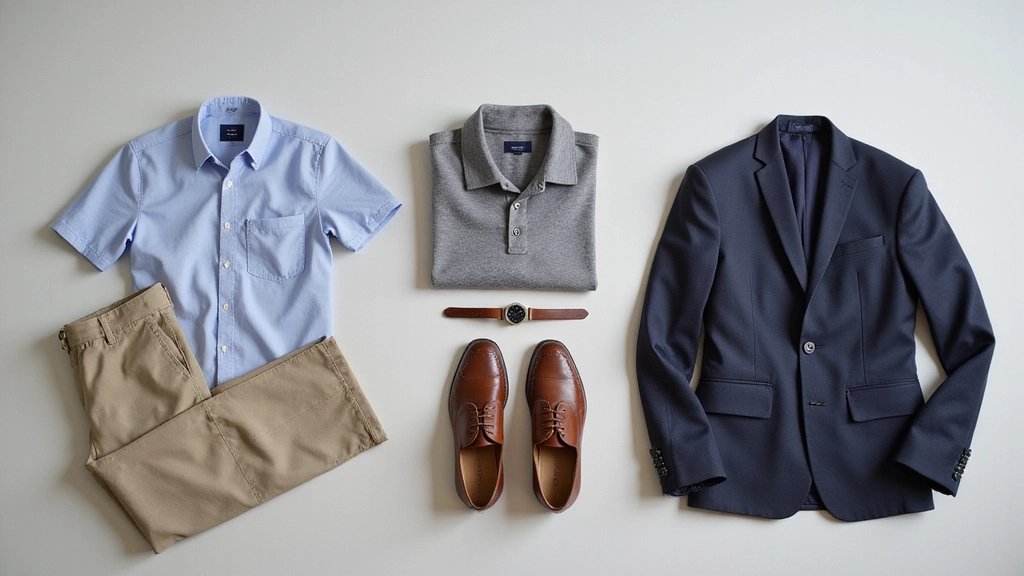
Baseline: what defines business casual
Business casual strikes the perfect balance between polished professionalism and everyday comfort. It’s your go-to dress code for looking put-together without the formality of a full suit. Think tailored chinos in modern fit paired with cotton-blend button-downs, knit polos that actually have structure, and leather loafers that work from desk to dinner.
The magic lies in three key elements: fit, fabric, and finish. Your pieces should be well-tailored but not restrictive, made from quality materials that breathe and move with you, and finished with clean lines and attention to detail. Business casual is about looking effortlessly sharp while feeling completely comfortable. When in doubt, aim for pieces that could work in a client meeting but won’t feel overdressed at the office coffee machine.
What business casual is not
Understanding what doesn’t qualify as business casual helps you avoid workplace wardrobe missteps and maintain that professional business casual attire standard.
- Athletic wear – gym clothes, yoga pants, and sports jerseys belong at the fitness center, not the office
- Distressed denim with rips, heavy fading, or that “I’ve had these since college” wear pattern
- Graphic tees with loud logos, novelty prints, or casual weekend slogans
- Worn-out pieces that look stained, wrinkled, or generally tired
- Beach-ready items like flip-flops, tank tops, or shorts, even in relaxed office environments
Context and condition matter as much as the garment itself. What works in a laid-back startup might feel inappropriate in a more traditional corporate setting. When you’re unsure about what qualifies as business casual for your workplace, lean slightly more polished rather than risk appearing underdressed.
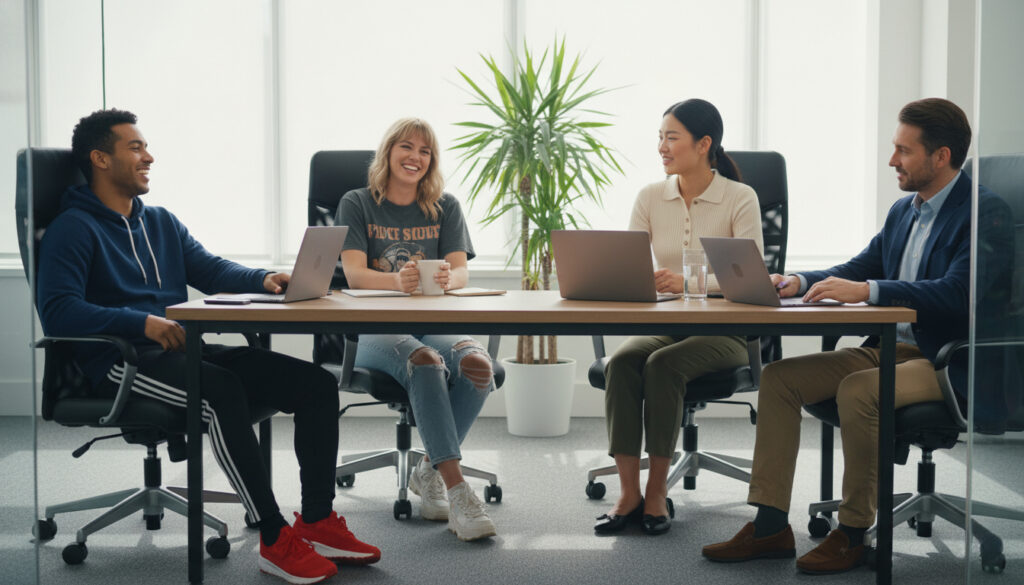
Smart casual vs. business casual
While business casual and smart casual might sound interchangeable, they serve different purposes and have distinct style expectations. Business casual prioritizes workplace appropriateness with structured pieces like tailored chinos, button-down shirts, and leather loafers that maintain a polished, professional appearance. Smart casual, on the other hand, leans more fashion-forward and flexible, allowing for creative combinations that might include designer sneakers, textured knitwear, or statement accessories.
The fabric choices reveal the key difference: business casual emphasizes refined materials like stretch wool, cotton blends, and quality knits that look crisp throughout the workday. Smart casual welcomes more experimental textures, patterns, and seasonal fabrics that prioritize style over strict workplace requirements. When it comes to footwear, business casual stays within the boundaries of leather dress shoes, loafers, and clean, minimalist leather sneakers in conservative colors. Smart casual opens the door to bolder footwear choices, including suede boots, fashion sneakers, or unique silhouettes that make a statement.
The deciding factor comes down to context: choose business casual for office meetings, client presentations, and workplace environments where professionalism takes priority. Opt for smart casual when you want to express personal style at networking events, creative workspaces, or social occasions that call for elevated yet relaxed attire.
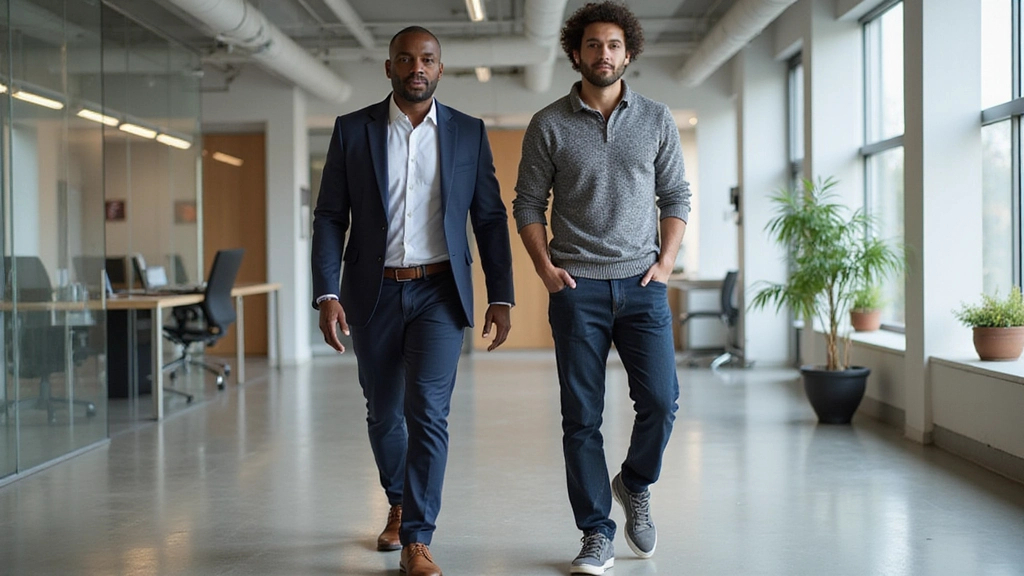
Key differences at a glance
- Purpose: Smart casual leans fashion-forward and flexible for social settings, while business casual stays work-ready and refined for professional environments
- Fabric choices: Smart casual embraces textured knits, casual cottons, and quality denim; business casual relies on structured wools, refined cotton blends, and polished fabrics
- Footwear approach: Smart casual allows clean leather sneakers, casual loafers, and on trend boots; business casual requires leather dress shoes, refined loafers, and professional pumps
- Layering style: Smart casual mixes creative combinations and statement pieces; business casual maintains classic blazers, coordinated separates, and consistent polish
- Overall feel: Smart casual prioritizes personal expression within polished boundaries; business casual emphasizes professional appropriateness with subtle style touches
When to choose each
Choose business casual for traditional office environments, client meetings, and presentations where professional business casual attire sets the right tone. It’s your go-to for networking events, job interviews, and any workplace situation where you want to project competence and reliability. Smart casual works better for creative industries, casual Friday office cultures, weekend networking mixers, and offsite team events where the vibe is more relaxed.
When you’re unsure, default to business casual. It’s easier to dial down your look by loosening a collar or removing a blazer than to elevate an outfit that started too casual. Read the room by observing what colleagues wear, checking company social media, or simply asking about dress expectations. Remember, being slightly overdressed shows respect for the occasion and leaves a polished impression.
Can I wear jeans in business casual?
Yes, you can wear jeans in many business casual environments, but success depends entirely on three key factors: your company’s specific dress code policy, the quality of your jeans, and how you style them. The key is choosing darker washes in refined fabrics that lean polished rather than casual. Think midnight indigo or charcoal rather than faded or distressed denim.
The magic lies in fit, finish, and pairing strategies. Opt for modern fit or slim fit jeans in premium fabrics like stretch cotton blends that maintain clean lines without being restrictive. Pair them with elevated pieces like a tailored blazer, knit polo, or crisp button-down shirt to balance the casual element. Complete the look with refined footwear, leather loafers, derbies, or minimalist leather sneakers work beautifully. The goal is creating an outfit where jeans feel intentional, not like you forgot to do laundry.
Skip jeans entirely for client meetings, formal presentations, or conservative office environments where they’re explicitly prohibited. When in doubt, err on the side of tailored chinos or five-pocket trousers instead. Remember, the best business casual approach is observing your workplace culture while maintaining that polished, professional edge. For more guidance on building a complete casual work wardrobe, explore our casual work attire essentials to find pieces that work seamlessly together.
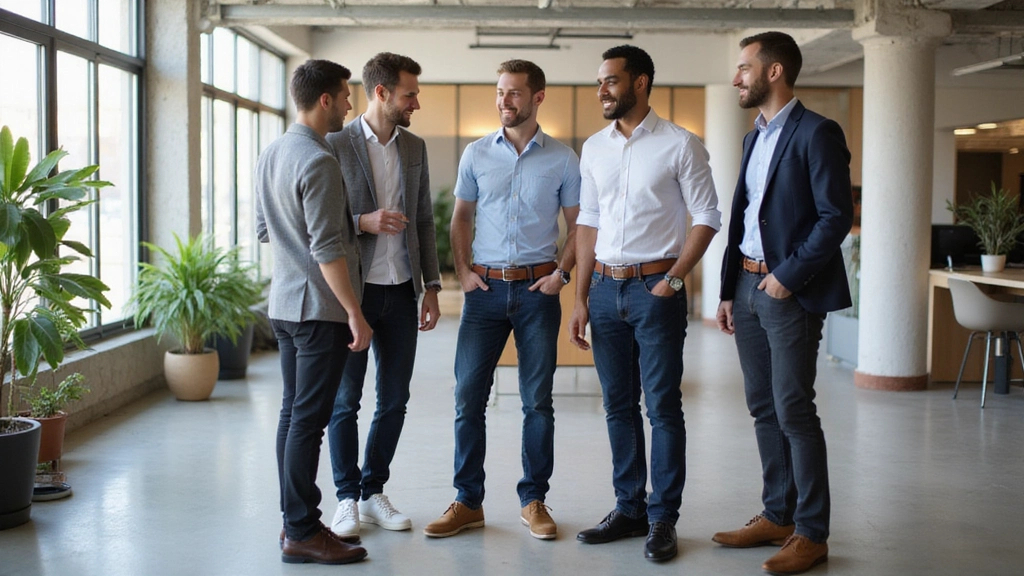
Polos and short sleeves in business casual
Polos can work well in business casual if chosen carefully. Opt for tailored polos with structured collars and quality fabrics, like cotton blends or performance knits, for a polished look that pairs with chinos or smart trousers.
Focus on refined details, reinforced collars, smooth finishes, and classic colors such as navy, charcoal, or sand. A tailored but comfortable fit ensures a professional appearance.
Polos are ideal in warmer months but layer well under sweaters or unstructured blazers for year-round use, making them a versatile staple in any business casual wardrobe.
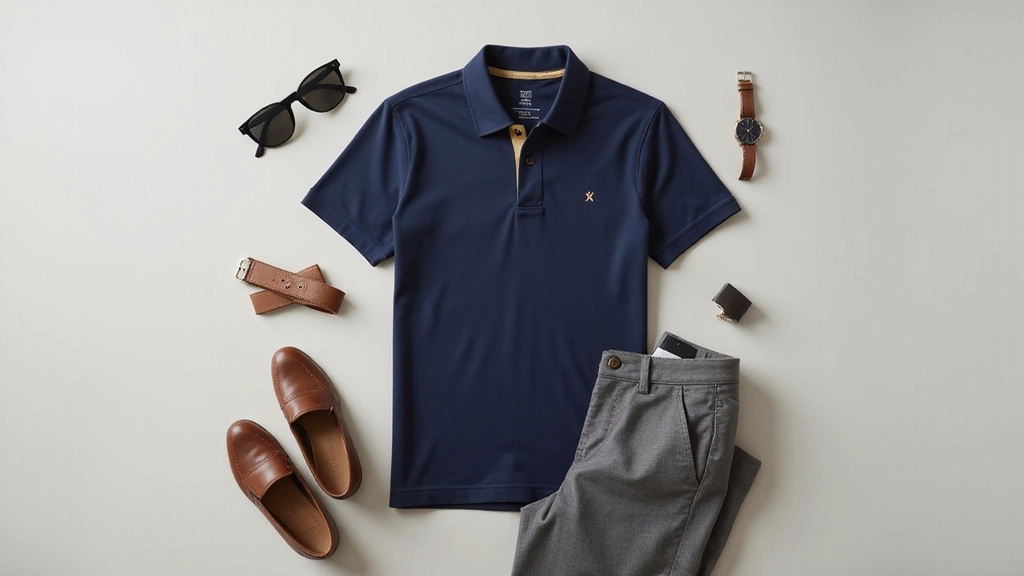
Shoes for business casual
Business casual shoes are essential for a polished professional look, balancing the formality of dress shoes with everyday comfort. The best options feature clean designs, quality materials, and versatility for both work and social settings.
Leather loafers, suede derbies, and simple oxfords are staple choices. Select shoes in neutral colors like brown, black, or navy to pair effortlessly with chinos or blazers. The fit should be refined yet comfortable – smart, but not overly formal. Proper care keeps your shoes sharp and extends their life. Regular conditioning, rotating pairs, and clean, well-maintained footwear all reinforce a professional appearance, completing your business casual outfit with confidence.
Shirts and layers that read professional
The foundation of professional business casual is built on well-fitted shirts that blend comfort with a polished look. Modern fit button-downs in stretch cotton or cotton-linen offer breathability and crisp lines. Quality polos with structured collars serve as a refined, versatile option for both meetings and networking events. Choose pieces that move with you and hold their shape throughout the day.
Mid-layers such as lightweight cardigans and fine-gauge sweaters add sophistication without extra bulk. Cotton-blend and merino wool sweaters layer effortlessly over button-downs or can be worn alone with tailored pants, offering year-round versatility that bridges formal and casual styles.
Light jackets are the finishing touch for a sharp business casual look. Unstructured blazers, knit sport coats, and lightweight wool jackets instantly elevate your outfit. The modern business casual wardrobe emphasizes a flexible fit and polished appearance, ensuring you look sharp whether you’re presenting in the office or meeting clients for coffee.
Example combinations that fit
- Midnight navy knit polo with charcoal chinos and leather loafers for polished casual meetings
- Light blue button-down layered under a charcoal lightweight sweater, paired with olive five-pocket trousers and suede derbies
- White button-down with a modern fit blazer in charcoal, dark wash chinos, and minimalist leather sneakers for flexible office days
- Heather gray knit polo topped with a navy cotton-blend cardigan, paired with khaki chinos and leather loafers
- Striped button-down under a lightweight merino sweater, with navy five-pocket trousers and brown leather oxfords for client presentations
Decoding the dress code in practice
Before you head out the door, run through these three quick checks to nail your business casual look. First, assess the fit, your clothes should feel tailored but not tight, allowing you to move comfortably while maintaining clean lines. Next, evaluate the fabric quality and condition. Professional business casual attire means choosing materials that look refined and wrinkle-free, avoiding anything too casual or worn. Finally, examine the finish details like pressed seams, polished shoes, and proper grooming.
The goal is simple: aim for neat, tailored, and comfortable every time. When you’re questioning what qualifies as business casual, remember that it’s better to lean slightly more polished than underdressed. Your outfit should feel effortless while signaling that you take your professional appearance seriously. Trust your instincts, and you’ll strike the right balance between comfort and credibility.
Seasonal and office-type playbooks
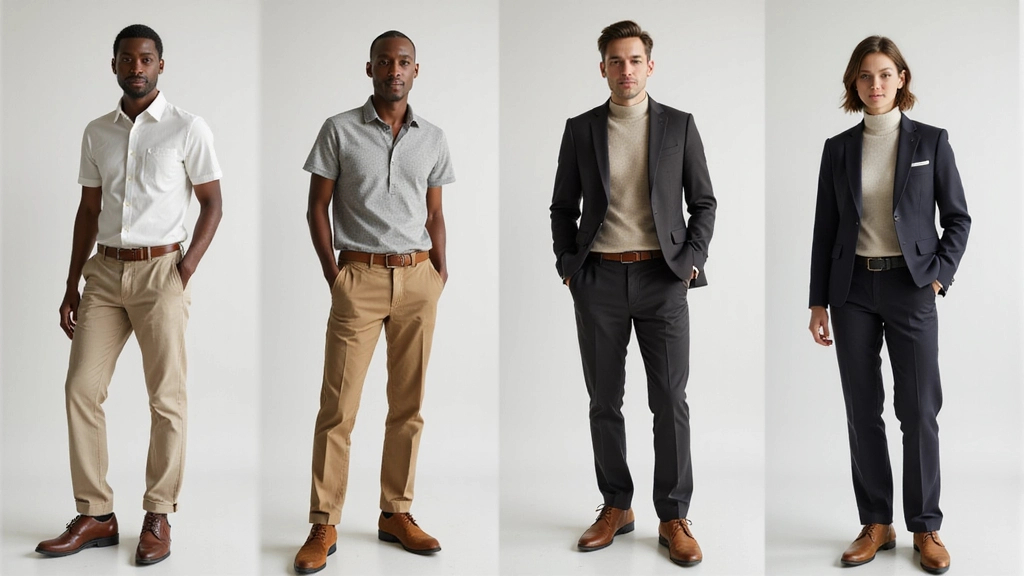
Business casual standards vary greatly by office and season, making it important to understand your workplace culture as you build a versatile wardrobe. Tech companies typically favor a relaxed look, think modern chinos and lightweight polos, while finance and consulting workplaces usually expect tailored trousers, button-down shirts, and smart loafers. Customer-facing roles often require the most polished style, with structured pieces that project professionalism and confidence.
As seasons change, update your business casual wardrobe strategically to maintain a professional appearance. For spring and summer, opt for breathable fabrics like cotton-linen blends, lightweight chinos, and moisture-wicking polos, complemented by leather loafers or suede drivers. In fall and winter, choose richer textures like wool trousers, cashmere or merino sweaters, and leather dress shoes to stay sharp in cooler weather. Layering with cardigans or blazers helps you adapt throughout the day. When in doubt, it’s better to dress slightly more polished than too casual, especially during seasonal transitions or when navigating a new office environment.
Seasonal outfit ideas
- Spring: Swap heavy wool trousers for lightweight chinos and trade thick sweaters for cotton polos or linen-blend button-downs paired with unstructured blazers.
- Summer: Choose breathable fabrics like cotton dress shirts with rolled sleeves, five-pocket trousers in light sand or navy, and leather loafers instead of closed-toe boots.
- Fall: Layer with cashmere cardigans over knit polos, add textured wool sweaters in charcoal or burgundy, and transition to suede loafers or leather derbies.
- Winter: Embrace rich textures like herringbone blazers, wool trousers in modern fit, merino sweaters, and polished leather boots for warmth without sacrificing style.
- Year-round staples: Keep versatile pieces like stretch wool trousers, quality cotton shirts, and leather dress shoes that work across all seasons with simple layering adjustments.
5 ready-to-wear outfit formulas
- Navy knit polo + charcoal cardigan + tailored khaki chinos + brown leather loafers
- White button-down + midnight navy blazer + charcoal five-pocket trousers + black derbies
- Light blue dress shirt + grey quarter-zip + modern fit navy chinos + suede brogues
- Heather polo + lightweight merino sweater + charcoal wool trousers + leather sneakers
- Chambray button-down + navy sport coat + stone chinos + cognac oxfords
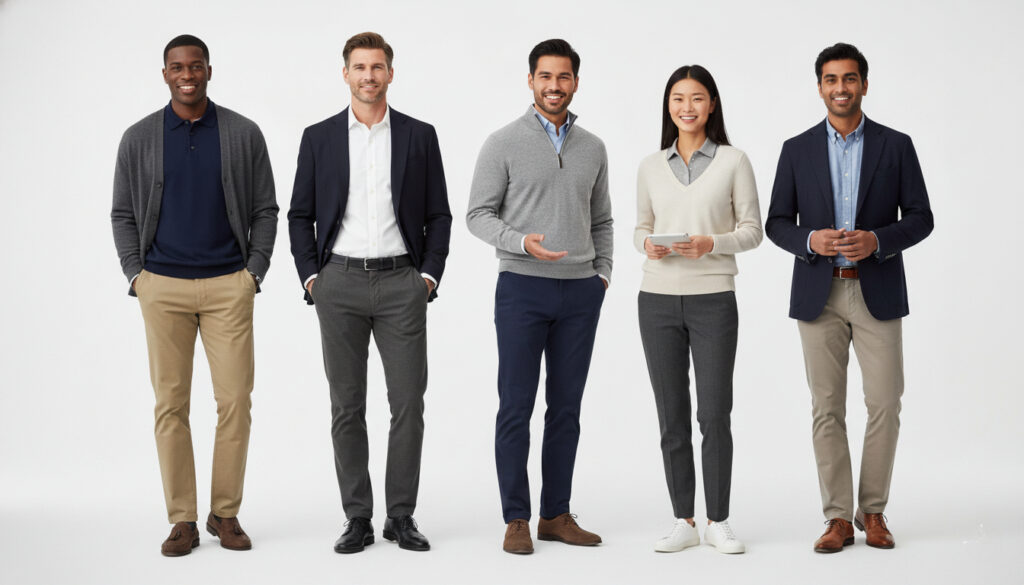
Do’s and don’ts to remember
- Do ensure a tailored fit in all garments. Well-fitted chinos, dress shirts, and blazers create a refined silhouette that reads professional in any business casual setting.
- Do invest in quality fabrics like stretch wool, cotton blends, and breathable materials that maintain their shape and appearance throughout the workday.
- Do choose leather loafers, oxfords, or minimalist leather sneakers in neutral colors. Clean, polished footwear elevates your entire look.
- Do maintain consistent grooming standards. A neat appearance reinforces the professional polish that business casual requires.
- Do observe your office culture and err on the side of being slightly more polished when unsure about expectations.
- Do layer thoughtfully with cardigans, knit polos, or lightweight blazers to add sophistication to basic pieces.
- Don’t wear wrinkled, faded, or poorly maintained clothing. Condition and cleanliness matter as much as style in professional settings.
- Don’t choose overly casual footwear like athletic trainers, sandals, or worn-out shoes that detract from your polished appearance.
- Don’t ignore fit in favor of trends. Oversized or too-tight clothing undermines the refined aesthetic business casual demands.
- Don’t assume all offices interpret business casual the same way. When starting a new role, observe team norms before pushing boundaries.
- Don’t neglect the finishing touches. Proper grooming, clean accessories, and attention to detail complete your professional look.
What is business casual?
Business casual is professional business casual attire that combines tailored, polished pieces with comfortable fabrics and relaxed fits, suitable for most office environments. It’s what qualifies as business casual when you need to look refined and work-ready without the formality of traditional business dress,think chinos with button-downs, knit polos with blazers, and leather loafers instead of athletic shoes.
What defines business casual?
- Refined fabrics – Think cotton blends, stretch wool, and quality knits that hold their shape and resist wrinkles
- Clean finishes – Pressed seams, structured collars, and details that look intentional, not casual
- Polished footwear – Leather loafers, derbies, or minimalist leather sneakers in neutral tones
- Tailored fit – Clothes that skim your frame without being too tight or too loose
- Professional presentation – Everything should look fresh, well-maintained, and workplace-appropriate
Can sneakers be business casual?
Yes, sneakers can work in business casual settings, but they need to meet specific criteria. Choose minimalist leather sneakers in neutral colors like white, black, or navy that maintain clean lines and a refined silhouette. The key is pristine condition, no scuffs, stains, or visible wear that could undermine your professional appearance.
However, context matters significantly. Read your office culture and company policy carefully, as some workplaces remain strict about traditional footwear. When in doubt, pair your leather sneakers with tailored chinos and a button-down to elevate the overall look. Remember that athletic shoes, canvas sneakers, or anything with bold logos typically won’t make the cut for business casual environments.
Final checklist and next steps
Before you head out, run through our four-point check: Does your fit feel tailored without being tight? Are your fabrics refined and wrinkle-free? Do your shoes look polished and professional? Is your overall finish clean and coordinated? If you can answer yes to all four, you’ve mastered what qualifies as business casual.
Ready to elevate your professional business casual attire? Whether you need expert guidance on fit or want to explore new styles, we’re here to help. Get fitted at your nearest location for personalized advice, rent your look for upcoming events, or pick up near you for convenient shopping. The right business casual wardrobe starts with the right partner, and that’s exactly what you’ll find with us.
More FAQ: quick answers
Business casual means polished pieces that split the difference between formal suiting and weekend wear. Think tailored chinos, button-down shirts, knit polos, and leather shoes that look professional but feel comfortable.
Yes, but only if your company allows them and they’re dark, well-fitted, and paired with refined pieces like blazers or quality knits. When in doubt, stick with chinos.
Clean, minimalist leather sneakers in neutral colors can work in progressive offices, but traditional leather shoes like loafers or oxfords are always the safer choice.
Yes, when they’re well-fitted and made from quality fabrics. Pair them with tailored trousers and avoid anything too sporty or casual.
Skip athletic wear, flip-flops, overly wrinkled clothes, anything too tight or loose, and items with large logos or graphics. The goal is looking put-together without being stuffy.

